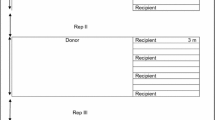Abstract
Fertile interspecific progenies between Oryza sativa L. and O. glaberrima Steud. were produced through backcrossing and doubled haploid breeding (DHB). Backcrossing with the O. sativa parents increased fertility and helped combine the O. sativa and O. glaberrima features. The use of DHB to generate a large proportion of doubled haploids from interspecific F2 hybrids, helped overcome constraints associated with the conventional breeding of these species, such as: (1) slow fixation of the lines, (2) frequent partial sterility of the progenies and (3) low recovery of useful recombinants.
Although true interspecific progenies between O. sativa and O. glaberrima were generally rare, their occurrence in some populations was as high as 30%. Some progenies combined the high yield potential of O. sativa, a result of high spikelet number caused by secondary branches on the panicle, with useful traits of O. glaberrima such as rapid leaf canopy establishment and high N responsiveness. The progenies partly inherited the O. glaberrima parents' high specific leaf area (SLA) during early growth, theoretically improving competitiveness with weeds, and from the O. sativa parents the rapid decrease in SLA towards the reproductive stage, theoretically allowing for high leaf photosynthetic rates and high grain yield. Research is in progress to develop new interspecific plant type concepts for resource poor, weed prone upland rice environments in West Africa.
Similar content being viewed by others
References
Arraudeau, M., 1992. Upland rice breeding concepts, strategies, accomplishments, problems. Briefing paper for brainstorming session in PBGB Division. 11 October 1992.
Bidaux, J.M., 1978. Screening for horizontal resistance to rice blast (Pyricularia oryzae) in Africa. In: I.W. Buddenhagen & G.J. Persley (Eds.), Rice in Africa. pp. 159–174. Academic Press, London.
Brar, P.S. & G.S. Khush, 1986. Wide hybridization and chromosome manipulation in cereals. In: D.A. Evans, W.R. Sharp & P.C. Ammirato (Eds.), Handbook of plant cell culture. Vol 4. pp. 221–256.
Carpenter, A.J., 1978. Rice history. In: I.W. Buddenhagen & G.J. Persley (Eds.), Rice in Africa. pp. 3–10. Academic Press, London.
CHU, C.C., C.S. Wang, C.S. Sun, C. Hsu, K.C. Yin, C.Y. CHU & F. Bi 1975. Establishment of an efficient medium for anther culture of rice through comparative experiments on nitrogen sources. Sci. Sinica 18: 659–668.
De Kochko, A., 1987. Isozymic variability of traditional rice, Oryza sativa L. in Africa. Theor. Appl. Genet. 73: 675–826.
Dindhuhn, M. & P.Y. Le Gal, 1996. Effect of drainage date on yield and dry matter partitioning in irrigated rice. Field Crop Research (in press).
Dingkuhn, M., M.P. Jones & A Sow, 1996. New high-yielding, weed competitive plant types drawing from O. sativa and O. glaberrima genepools. In: WARDA. 1996. Annual Report for 1995. pp. 4–12.
Fofana, B., T. Koupeur, M.P. Jones & D.E. Johnson, 1995. The development of rice varieties competitive with weeds. Brighton Crop Protection Conference. Weeds — 1995, Volume 1. pp. 187–192. 49 Downing street, Farnham, Surrey GU9 7PH, UK.
Guiderdoni, E., E. Galinato, J. Luistro, & G. Vergara, 1992. Anther culture of tropical japonica x indica hybrids of rice (O. sativa L.). Euphytica 62: 219–224.
IRRI., 1988. Standard Evaluation System for Rice. International Rice Research Institute Los Banos, Philippines.
Jacqout, M., 1977. IRAT and Rice genetic resources. Paper presented at the Rice genetic conservation workshop. IRRI/IBPGR. December 1977. p. 11.
Jena, K.K. & G.S. Khush, 1990. Introgression of genes from Oryza officinalis ex Watt. to cultivated rice, O. sativa L. Theor. Appl. Genet. 80: 737–745.
Jennings, P.R., W.R. Coffman & H.E. Kauffman, 1979. Rice improvement. Intl. Rice Res. Inst., Los Banos, Laguna, Philippines.
Koffi, G., 1980. Etude de la Variabilité des Riz Africains en Vue de leur Utilisation en sélection. Bouaké, Côte d'Ivoire.
Kropff, M.J., H.H. van Laar & R.B. Matthews. 1994. ORYZA 1. A basic model for irrigated lowland rice production. Intl. Rice Res. Inst. Los Banos, Philippines.
Murashige, T. & F. Skoog, 1962. A revised medium for rapid growth and bio-assay with tobacco tissue culture. Physiologia Plantarum, 15: 473–497.
Oka, H.I., 1988. Origin of cultivated rice. Developments in Crop Science. Vol. 14, Japan Scientific Society Press okyo and Elsevier. Amsterdam
Second, G., 1984. Relations évolutives chez le genre oryza et processus de domestication des riz. Etude set theses, ORSTOM, Paris, France.
Takeoka, T., 1965. Taxonomy and chromosome numbers of African representatives of the Oryza officinalis complex. Bot. Mag. (Tokyo) 78: 198–201.
WARDA, 1992. Annual Report for 1991. West Africa Rice Development Association, 01 BP 2551, Cote d'Ivoire.
WARDA, 1993. Annual Report for 1992. West Africa Rice Development Association, 01 BP 2551, Cote d'Ivoire.
WARDA, 1994. Annual Report for 1993. West Africa Rice Development Association, 01 BP 2551, Cote d'Ivoire.
Author information
Authors and Affiliations
Rights and permissions
About this article
Cite this article
Jones, M.P., Dingkuhn, M., Aluko/snm>, G.K. et al. Interspecific Oryza Sativa L. X O. Glaberrima Steud. progenies in upland rice improvement. Euphytica 94, 237–246 (1997). https://doi.org/10.1023/A:1002969932224
Issue Date:
DOI: https://doi.org/10.1023/A:1002969932224




